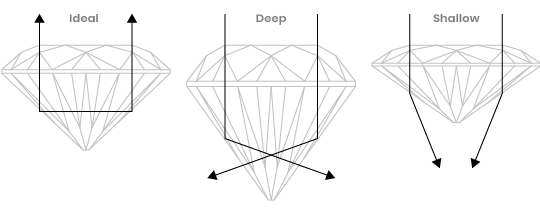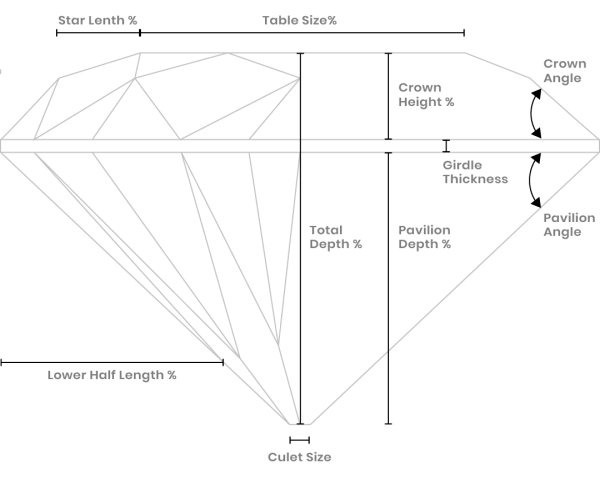All About Diamonds
Diamond Education Information
We are committed to educating our customers so that they know they are getting the best diamond at the best price.
Cut
An ideal cut diamond has proportions which enable it to reflect back, all, or most of the light which enters it. This ability maximizes its brilliance! And, an ideal cut diamond also has the ability to refract (break up into colors, like a rainbow) the light reflected from it.


Diamond Makes
The large facet, at the top of the stone, is called the table. It’s shaped like an octagon. The triangular shaped facets, around the table, are called top stars. The large rhombus shaped facets, between the girdle and the table, are called bezels. The smaller triangular shaped facets, along the girdle, are called, half stars. And, an the facets above the girdle, when taken together are called the diamond’s crown .
It’s not really important for you to remember the names of all these
facets. I’ve listed them here for your general knowledge. But, there is one thing here, that’s very important for you to know! And, that’s the function of the crown.
A diamond’s crown, is the part of the stone that refracts the reflected light, into its colored components (like a prism)! Therefore, a diamond’s crown determines its fire!
Color
Color is the term which is used, in the industry, to describe the intensity of hue, or tint, in the diamond material. Usually, this tint is yellow, but it can also be brown, pink, blue or green. In fact, if the tint of yellow, pink, blue, or green, is intense enough, the diamond is categorized as a fancy color!


Diamond Color Descriptions
Ninety-nine percent of all polished diamonds, are tinted yellow or brown. Less than one percent of them are colorless! (Containing no tinting, at all.) And, only a very small percentage of them are considered near colorless. (These contain only the slightest tinting.)
In the United States, an alphabetic scale is used to indicate a diamond’s color. This scale was set up by the Gemological Institute of America. The highest color in this scale, actually, the total absence of color, is represented by the letter D. As we ascend the alphabet, each letter represents very small additional amounts of tint. Please keep in mind that the variations between each of these color grades, are extremely small and subtle.
Clarity
Clarity is the measure of a diamond’s purity! Each clarity grade describes, to what degree, a diamond is included. (By the way, the imperfections found within diamonds are called inclusions or flaws)


Internal flaws in diamonds
I. Cleavage -A break in the diamond’s grain. It is also known in the industry as a “Gletz”. Gletzes are easy to find, and range in size from very small to large.
2. Fracture – Like a gletz, but it can also appear in different directions.
3. Feather – Looks like a small feather!
4. Bubble or Crystal – Can be small or large, and light or dark, in color.
5. Carbon Spot or Pique -A dark inclusion, usually graphite. When of medium size, these inclusions are easier to see, than other types of inclusions of the same size.
6. Pinpoint – Like the name implies, hard to find.
7. Cloud -A group of tiny pinpoints together fanning a nebula or haze.
8. Knot- Like in a piece of wood.
9. Bearded Girdle – Hairlike fractures which extend into the stone along the girdle.
Carat (Size)
What is a carat? It’s a unit of weight! And, a very small one at that! There are five carats, in one gram. If you’ve ever marveled at the size of some rich or famous person’s 5 carat stone, you can console yourself by remembering it only weighs 1 little gram!


Diamond Sizing Descriptions
To make weighing even more accurate, the carat itself is divided into 100 parts, called points. If we have a 1 /2 carat stone, it weighs 50 points or .50 cts.
A 10 point stone weighs .10 cts., and a 1 carat stone weighs 100 points or 1.00 cts.
To really understand how size affects price, let’s make believe we have to go looking for diamond rough (uncut stones found in nature). Imagine that we had the time, and the energy, to hunt around the areas of the world where it’s found. After a short while, we’d discover that nature contains hundreds of billions of rough (uncut) diamonds, this size.


